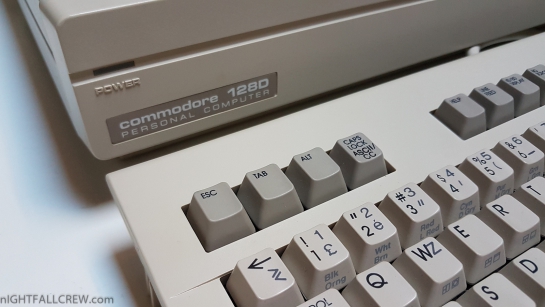Commodore 128DCR (Boxed)

The Commodore 128, also known as the C128, C-128, C= 128 is the last 8-bit home computer that was commercially released by Commodore Business Machines (CBM). Introduced in January 1985 at the CES in Las Vegas, it appeared three years after its predecessor, the bestselling Commodore 64.
The Commodore 128DCR model features a stamped-steel chassis in place of the plastic version of the C128D (with no carrying handle), a modular switched-mode power supply similar to that of the C128D, retaining that model’s detachable keyboard and internal 1571 floppy drive. A number of components on the mainboard were consolidated to reduce production costs and, as an additional cost-reduction measure, the 40 millimeter cooling fan that was fitted to the D model’s power supply was removed. However, the mounting provisions on the power supply subchassis were retained, as well as the two 12-volt DC connection points on the power supply’s printed circuit board for powering the fan. The C128DCR mounting provision is for a 60mm fan.
A significant improvement introduced with the DCR model was the replacement of the 8563 video display controller (VDC) with the more technically advanced 8568 VDC and equipping it with 64 kilobytes of video RAM—the maximum amount addressable by the device. The four-fold increase in video RAM over that installed in the “flat” C128 made it possible, among other things, to maintain multiple text screens in support of a true windowing system, or generate higher-resolution graphics with a more flexible color palette. Little commercial software took advantage of these possibilities.
The C128DCR is equipped with new ROMs dubbed the “1986 ROMs,” so-named from the copyright date displayed on the power-on banner screen. The new ROMs address a number of bugs that are present in the original ROMs, including an infamous off-by-one error in the keyboard decoding table, in which the ‘Q’ character would remain lower case when CAPS LOCK was active. Some software will only run on the DCR, due to dependencies on the computer’s enhanced hardware features and revised ROMs.
Despite the DCR’s improved RGB video capabilities, Commodore did not enhance BASIC 7.0 with the ability to manipulate RGB graphics. Driving the VDC in graphics mode continues to require the use of calls to screen-editor ROM primitives or their assembly language equivalents or by using third-party BASIC language extensions, such as Free Spirit Software’s “BASIC 8″, which adds high-resolution VDC graphics commands to BASIC 7.0.
Gallery:
source: wikipedia












Recent Comments